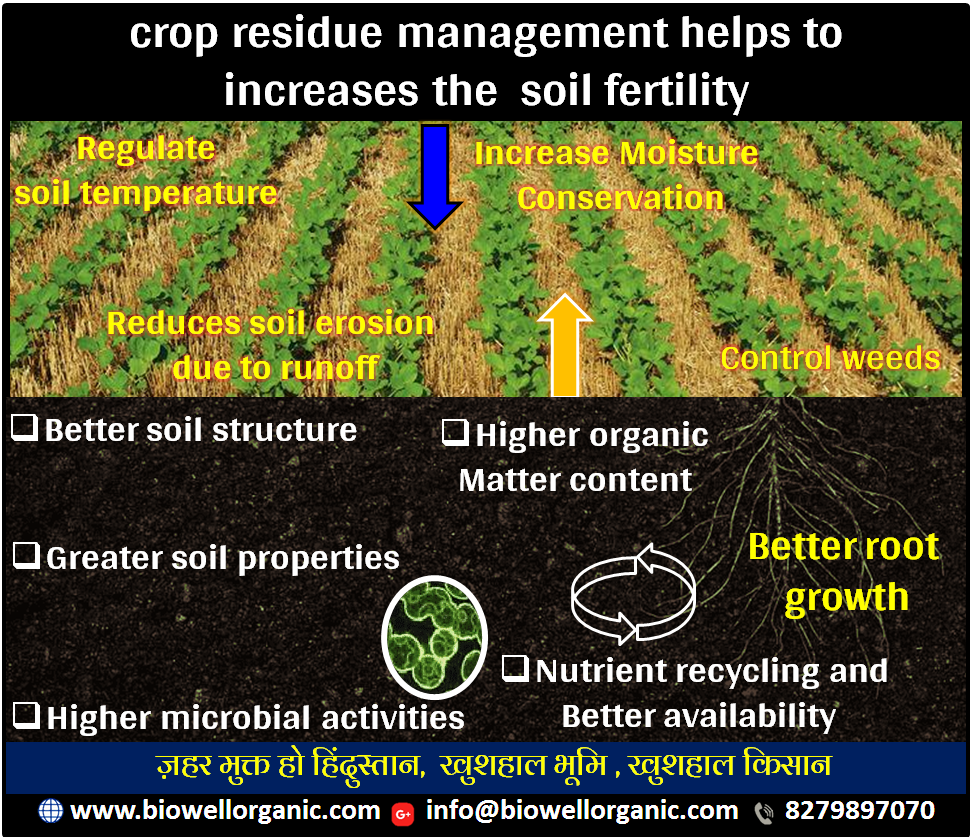Ahmedabad
(Head Office)Address : 506, 3rd EYE THREE (III), Opp. Induben Khakhrawala, Girish Cold Drink Cross Road, CG Road, Navrangpura, Ahmedabad, 380009.
Mobile : 8469231587 / 9586028957
Telephone : 079-40098991
E-mail: dics.upsc@gmail.com

Crop Residue Management
News: Recently, the SC asked Punjab government why it could not bear the manpower expenses and running costs of crop residue management machines so that it could be 100% free for marginal farmers.
What is Crop Residue and what is its use?
• Crop residues are the materials left over after a crop harvest. They may be present in the form of leaves, stalks, stems, seeds, etc.
They can be used in many ways as follows:
• Adding soil organic matter: They are extremely helpful in adding soil organic matter.
• Feed, fodder, fiber, and construction material: They are generally used as feed, fodder, fiber, and construction material.
• Biofertilizer: They can be used as biofertilizers.
• Use in agronomic practice: For example, as a straw bed to produce crops (e.g., in strawberry cultivation).
• Increase the soil’s water infiltration and retention capacity: They increase the soil’s water infiltration and retention capacity.
What are the consequences of Unscientific crop residue management?
• Soil degradation: Both crop residue burning and removal are the primary causes of soil degradation in some developing countries.
• Loss of soil organic carbon (SOC): Large number of studies show adverse effects of crop residue burning on soil organic carbon (SOC), soil fertility and soil health, and long-term sustainability of crop production.
• Loss of nutrients: Crop residue burning is not a management solution as it causes environmental deterioration, crucial nutrient loss, and the disruption of beneficial microbes in the soil.
• Increase in Greenhouse gas emissions: Burning of crop residue releases carbon dioxide, carbon monoxide, methane, sulphur oxide, nitrogen oxide gases. These gases are responsible for aggravating the global calamity of climate change.
• Air pollution: Burning of crop residues is a major cause of air pollution, particularly in regions where this practice is prevalent.
• Health issues: The smoke from burning crop residues can cause respiratory and other health issues for people living in nearby areas.

What steps have been taken to prevent unscientific crop residue management in India?
• National Green Tribunal (NGT) order in 2015 prohibited crop residue burning in any part of the NCT of Delhi and the states of Punjab, Rajasthan, Uttar Pradesh, and Haryana.
• Crop Residue Management (CRM) scheme was launched in 2018-19 with a multipronged strategy. Under this scheme, financial assistance of 50% is provided to the farmers for purchase of CRM machines like ‘Happy seeder’, ‘rotavators‘, ‘superseeder’ etc.
• Financial assistance of 80% is provided to cooperative societies, Farmer Producer Organisations and Panchayats for the establishment of Custom Hiring Centres in villages. These centres provide CRM machinery to farmers on rental basis at affordable rates.
• Framework of Commission for Air Quality Management (CAQM)- which is a statutory body formed under the Commission for Air Quality Management in National Capital Region and Adjoining Areas, Act 2021. CAQM has provided a framework to tackle the problem of air pollution due to stubble burning. The State Governments of Punjab, National Capital Region (NCR) States and the Government of National Capital Territory of Delhi (GNCTD) have developed detailed monitorable action plans based on this framework.
What are the scientific methods of Crop residue management?
• Pusa Decomposer Technology developed by The Indian Council of Agricultural Research (ICAR) to biologically decompose paddy stubble in the farm. It’s a microbial solution available both in liquid and capsule form for accelerated decomposition of straw.
• Biochar Formation: Biochar is a type of charcoal that is produced by pyrolysis of plant residues. It can be used as a soil amendment.
• Happy Seeder- Happy Seeder, which is a tractor-mounted machine, cuts and lifts rice straw, sows wheat into the bare soil, and deposits the straw over the sown area as mulch. This can be used for stubble management instead of burning the stubble.
• Mushroom Cultivation: Crop residues can be used for mushroom cultivation.
• Mulching: Mulching is the practice of leaving crop residue on the soil surface to protect the soil from erosion and retain moisture.
What else can be done?
• Use of MGNEGA scheme for harvesting and composite stubble burning. It can be an innovative approach towards CRM.
• Increase awareness amongst farmers about consequences of stubble burning on the lives and health of people.
• Use of new and improved varieties of rice and wheat crop like Pusa Basmati-1509 and PR-126, mature quickly. The use of these varieties provides more time to the farmers to clear.

Address : 506, 3rd EYE THREE (III), Opp. Induben Khakhrawala, Girish Cold Drink Cross Road, CG Road, Navrangpura, Ahmedabad, 380009.
Mobile : 8469231587 / 9586028957
Telephone : 079-40098991
E-mail: dics.upsc@gmail.com
Address: A-306, The Landmark, Urjanagar-1, Opp. Spicy Street, Kudasan – Por Road, Kudasan, Gandhinagar – 382421
Mobile : 9723832444 / 9723932444
E-mail: dics.gnagar@gmail.com
Address: 2nd Floor, 9 Shivali Society, L&T Circle, opp. Ratri Bazar, Karelibaugh, Vadodara, 390018
Mobile : 9725692037 / 9725692054
E-mail: dics.vadodara@gmail.com
Address: 403, Raj Victoria, Opp. Pal Walkway, Near Galaxy Circle, Pal, Surat-394510
Mobile : 8401031583 / 8401031587
E-mail: dics.surat@gmail.com
Address: 303,305 K 158 Complex Above Magson, Sindhubhavan Road Ahmedabad-380059
Mobile : 9974751177 / 8469231587
E-mail: dicssbr@gmail.com
Address: 57/17, 2nd Floor, Old Rajinder Nagar Market, Bada Bazaar Marg, Delhi-60
Mobile : 9104830862 / 9104830865
E-mail: dics.newdelhi@gmail.com